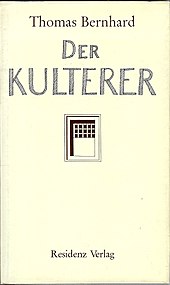The cultist
Der Kulterer is a story written in 1962 by the Austrian writer Thomas Bernhard . It is about a stay in prison and the upcoming release of the main character, the cultist.
Table of contents
The main character, a simple, reserved and undemanding person, fits in without rebellion in the brutal penal system, where blows with a rubber stick on the head of the prisoners with the most simple contradictions are common.
He recognizes: "Rebellion is megalomania". Nor would it be justified, since he accepts his sentence in view of his crime. He almost becomes the darling of the guards, who do not prefer him but also do not punish him unfairly.
The penitentiary becomes a free space for cultists in which he learns to understand the world and “God's world”, “heaven and hell” for the first time as components of a meaningful system. While the other prisoners, basically brutal fellows, violent and rebellious, wear themselves out and wear themselves out on the system, the cultist succeeds in making the place of his stay in prison a place of self-realization: he begins to write down little stories at night in the dark, which occur to him half in a dream and which he spins away while awake. Through these stories he also finds access to the other prisoners who, although mostly not understanding his literature, accept it and are happy to hear the readings he gives.
interpretation
It turns out that the "negative idyll" often proven in Bernhard's case is already fully developed in this early story: the subject's self-realization happens unexpectedly where there is violence and darkness, where the individual has to experience rape every day, except for basic needs.
The much-described “Ortstopos” in Bernhard's work has not yet been worked out against the backdrop of a penal institution in the absurd constellation of later works such as Das Kalkwerk . Bernhard describes the location very clearly and almost logically. The prison complex is an old abandoned monastery in which people have always refrained from living in the outside world (even if they used to voluntarily) and into which even today irritations rarely penetrate: letters and parcels from the outside world or that Laughter from peasant women from the surrounding fields.
Nevertheless, reality leaves its mark on the writer: He only writes sad stories in which he can, however, create reality to a certain extent and learn to understand the world.
So it is not surprising that the cultist looks forward to his imminent dismissal with skepticism and fear. He rightly fears the loss of his shelter; his path will not lead to freedom, but to a landscape that is “steaming with hopelessness” and in which another literary creative process is not believable.
expenditure
The story appeared with illustrations by Peter Herzog first in 1969 in the prose volume An der Baumlinie in the Residenz-Verlag Salzburg and again in 1974 together with the "Filmgeschichte" under the actual title. A new edition, also with Herzog's illustrations, took place in 2011 in the Insel-Bücherei .
filming
The screenplay, called "Filmgeschichte" by the publishing house, was written in 1973.
The book was filmed under the title “Der Kulterer” in 1973/74 as a joint production by ZDF and ORF with Helmut Qualtinger in the title role and directed by Vojtěch Jasný as a television film with a length of 77 minutes. The recordings were shot in the Garsten men's penal institution in Upper Austria , which was housed in a former monastery .
The first broadcast took place on March 6, 1974 in the night program of ZDF, the film was shown on ORF on April 16, 1974.
The actors were Helmut Qualtinger in the title role, Andreas Altmann , Harry Hornisch , Werner Schneyder , Fritz Thalhammer , Emmo Diem and Roland Barta .
Web links
- Filming of "Der Kulterer" in the Internet Movie Database (English)
